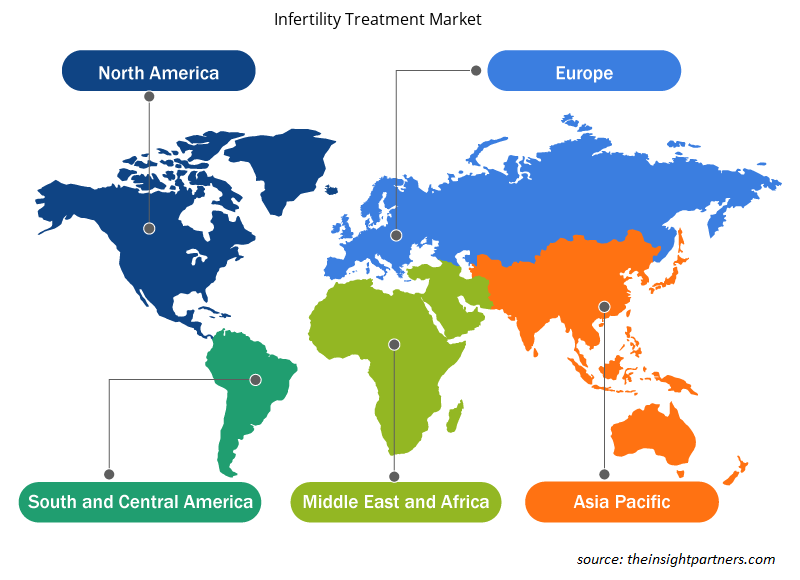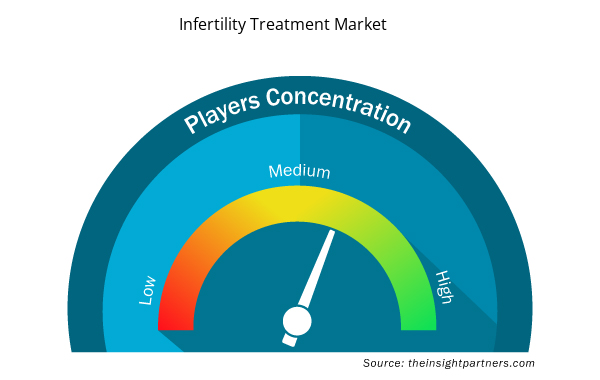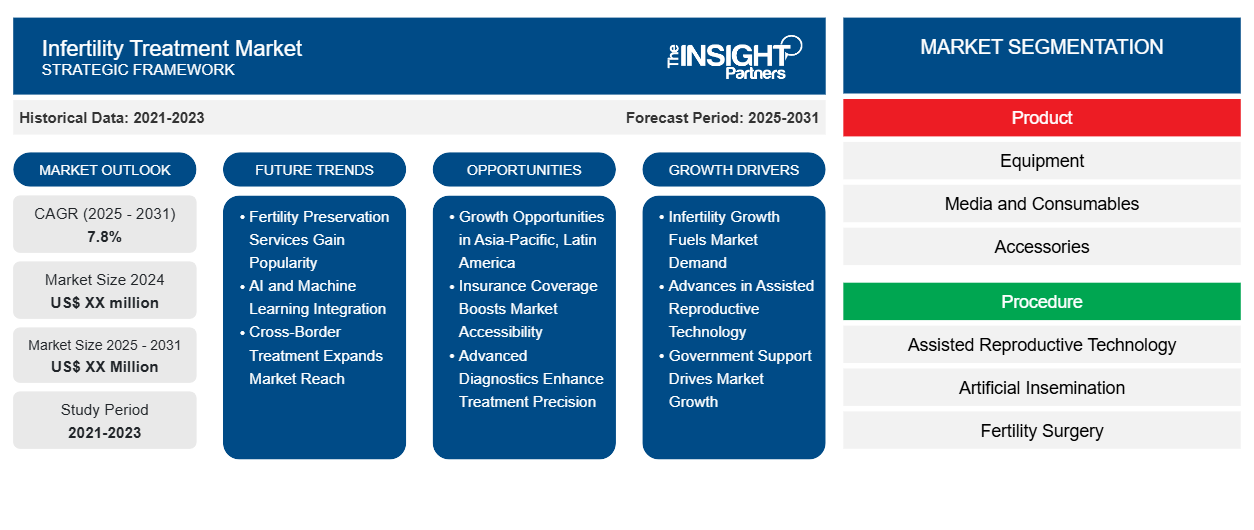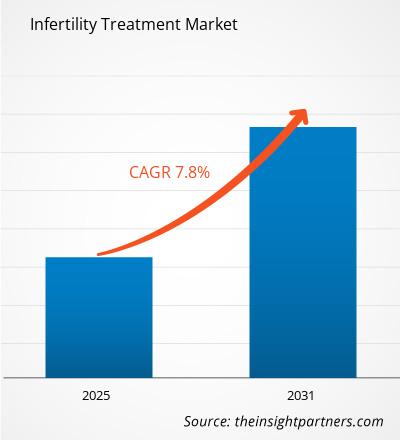Der Markt für Unfruchtbarkeitsbehandlungen wird voraussichtlich von 2023 bis 2031 eine durchschnittliche jährliche Wachstumsrate (CAGR) von 7,8 % verzeichnen, wobei die Marktgröße von XX Millionen US-Dollar im Jahr 2023 auf XX Millionen US-Dollar im Jahr 2031 wachsen wird.
Der Marktbericht zur Unfruchtbarkeitsbehandlung umfasst Analysen nach Produkt, Verfahren, Patiententyp und Endbenutzer. Die globale Analyse wird weiter auf regionaler Ebene und in die wichtigsten Länder unterteilt. Der Bericht bietet den Wert in USD für die oben genannte Analyse und Segmente.
Zweck des Berichts
Der Bericht „Markt für Unfruchtbarkeitsbehandlungen“ von The Insight Partners soll die aktuelle Situation und das zukünftige Wachstum sowie die wichtigsten treibenden Faktoren, Herausforderungen und Chancen beschreiben. Dies wird verschiedenen Geschäftspartnern Einblicke geben, wie zum Beispiel:
- Technologieanbieter/-hersteller: Um die sich entwickelnde Marktdynamik zu verstehen und die potenziellen Wachstumschancen zu kennen, damit sie fundierte strategische Entscheidungen treffen können.
- Investoren: Durchführung einer umfassenden Trendanalyse hinsichtlich der Marktwachstumsrate, der finanziellen Marktprognosen und der Chancen entlang der Wertschöpfungskette.
- Regulierungsbehörden: Zur Regulierung von Richtlinien und Überwachungsaktivitäten auf dem Markt mit dem Ziel, Missbrauch zu minimieren, das Vertrauen der Anleger zu bewahren und die Integrität und Stabilität des Marktes aufrechtzuerhalten.
Marktsegmentierung für Unfruchtbarkeitsbehandlungen
Produkt
- Ausrüstung
- Medien und Verbrauchsmaterialien
- Zubehör
Verfahren
- Assistierte Reproduktionstechnologie
- Künstliche Befruchtung
- Fruchtbarkeitschirurgie
- Andere Verfahren zur Behandlung von Unfruchtbarkeit
Patiententyp
- Behandlung weiblicher Unfruchtbarkeit
- Behandlung männlicher Unfruchtbarkeit
Endbenutzer
- Fruchtbarkeitszentren
- Krankenhäuser und chirurgische Kliniken
- Forschungsinstitute
- Kryobanken
Endbenutzer
- Fruchtbarkeitszentren
- Krankenhäuser und chirurgische Kliniken
- Forschungsinstitute
- Kryobanken
Passen Sie diesen Bericht Ihren Anforderungen an
Sie erhalten kostenlos individuelle Anpassungen an jedem Bericht, einschließlich Teilen dieses Berichts oder einer Analyse auf Länderebene, eines Excel-Datenpakets sowie tolle Angebote und Rabatte für Start-ups und Universitäten.
- Holen Sie sich die wichtigsten Markttrends aus diesem Bericht.Dieses KOSTENLOSE Beispiel umfasst eine Datenanalyse von Markttrends bis hin zu Schätzungen und Prognosen.
Wachstumstreiber auf dem Markt für Unfruchtbarkeitsbehandlungen
- Wachstum bei Unfruchtbarkeit treibt Marktnachfrage an: Die zunehmende Flut von Unfruchtbarkeit aufgrund von Lebensstil, Alter und Umweltstressoren beschleunigt das Wachstum des Marktes für Unfruchtbarkeitsbehandlungen. Berichte haben einen solchen Trend unterstrichen, der eine konstante Nachfrage nach fortschrittlichen Behandlungen und Dienstleistungen hervorruft. Da die Unfruchtbarkeitsraten in verschiedenen Teilen der Welt steigen, nehmen Unternehmen, die auf dem globalen Markt für Unfruchtbarkeitsbehandlungen tätig sind, drastische Änderungen in der Wettbewerbsanalyse und -strategie vor, um den Bedürfnissen der Patientenbasis gerecht zu werden. Diese Nachfrage treibt das Marktwachstum an, da Gesundheitsdienstleister ihr Angebot erweitern und den Zugang zu reproduktiven Dienstleistungen verbessern
- Fortschritte in der assistierten Reproduktionstechnologie: Der andere Hauptgrund für das Marktwachstum sind die bedeutenden Fortschritte im Bereich der assistierten Reproduktionstechnologie, einschließlich In-vitro-Fertilisation und intrazytoplasmatischer Spermieninjektion. Diese Innovationen führten zu einer höheren Erfolgsquote und behandelten verschiedene Fälle von Unfruchtbarkeit, wodurch die Markttrends gestärkt wurden. Unternehmen führen durch kontinuierliche Technologieentwicklung PEST-Analysen durch, um die besten Praktiken zu ermitteln und mit anderen zu konkurrieren. ART, das sich in einer kontinuierlichen Entwicklungsphase befindet, trägt zum Wachstum des Marktes weltweit bei, da immer mehr Menschen nach effektiven, evidenzbasierten Lösungen suchen, die in den Marktanalyseberichten vorgestellt werden.
- Staatliche Unterstützung treibt Marktwachstum an: Zu den Treibern auf dem Markt für Unfruchtbarkeitsbehandlungen zählen staatliche Unterstützungsmaßnahmen, Zuschüsse und subventionierte Behandlungen. Die zunehmende Verfügbarkeit und insofern die Erschwinglichkeit solcher Maßnahmen verheißen Gutes für die Marktgröße. Die Regierungen verschiedener Regionen haben durch ihre Initiativen Unfruchtbarkeitsbehandlungen gefördert und damit das Wachstum des Marktes für Unfruchtbarkeitsbehandlungen angekurbelt. Diese freundliche Haltung der Regierungen verspricht eine positive Zukunft, was den Bericht zur Marktanalyse für Unfruchtbarkeitsbehandlungen betrifft, während die Wettbewerbsanalyse eine steigende Beteiligung der Anbieter zeigt, da die Politik Unfruchtbarkeitsbehandlungen für mehr Menschen verfügbar macht.
Zukünftige Trends auf dem Markt für Unfruchtbarkeitsbehandlungen
- Dienstleistungen zur Fruchtbarkeitserhaltung werden immer beliebter: Daher ist das wachsende Bewusstsein für Einrichtungen zur Fruchtbarkeitserhaltung wie das Einfrieren von Eizellen und Spermien einer der wichtigsten Trends auf dem Markt für Unfruchtbarkeitsbehandlungen. Da die Menschen ihre Elternschaft aufschieben, versuchen sie, durch solche Konservierungsdienste ein bisschen mehr Sicherheit zu erlangen. Wichtige Akteure versuchen daher, ihre Strategien auf dem Markt zu harmonisieren, um Lösungen anzubieten, die diesem Bedarf entsprechen. Sie wissen auch, dass die Kundschaft, die solche Konservierungsdienste in Anspruch nimmt, ihnen für einen längeren Zeitraum treu bleibt. Dieser Trend findet Resonanz in den Ergebnissen der SWOT-Analyse, die auf ein starkes Wachstum des Marktes hindeuten, da die Konservierung ein fester Bestandteil der Fortpflanzungsplanung wird.
- Integration von KI und maschinellem Lernen: Künstliche Intelligenz und die Integration von maschinellem Lernen in die Unfruchtbarkeitsdiagnostik sind die neuesten Revolutionen auf dem Markt, die die Behandlung präziser und individueller machen. Große Unternehmen der Branche haben KI-gestützte Techniken eingeführt, um die Diagnoseergebnisse und das Patientenerlebnis zu verbessern und so die Marktdynamik zu verändern. Diese Innovation passt gut zu prognostizierten Erkenntnissen über den Markt, die darauf hindeuten, dass die Nutzung von KI die Effizienz und Erfolgsraten steigern wird. KI-integrierte Marktstrategien stärken die Fähigkeiten der Anbieter und positionieren sie angesichts der sich entwickelnden Landschaft für Unfruchtbarkeitsbehandlungen wettbewerbsfähig.
- Grenzüberschreitende Behandlung erweitert Marktreichweite: Grenzüberschreitende Fruchtbarkeitsbehandlungen nehmen zu, da Patienten in verschiedenen Regionen nach erschwinglicherer Spezialbehandlung suchen. Dieser Trend ist einer der Faktoren, die zu einer Veränderung der Marktdynamik geführt haben; wichtige Akteure erweitern nun ihre Dienstleistungen, um internationale Kunden zu bedienen. Die Marktstrategien für Unfruchtbarkeitsbehandlungen sind nun darauf ausgerichtet, sicherzustellen, dass reisefreundliche Dienstleistungen für das Wachstum in Ländern mit gut etablierten Sektoren des Medizintourismus unterstützt werden. Die SWOT-Analyse zeigt, dass dies den globalen Markt für Unfruchtbarkeitsbehandlungen ankurbelt, da die unterschiedlichen Bedürfnisse der Patienten erfüllt werden und der Zugang zu spezialisierten Behandlungsmöglichkeiten zunimmt.
Marktchancen für Unfruchtbarkeitsbehandlungen
- Wachstumschancen im asiatisch-pazifischen Raum und in Lateinamerika: Diese Chancen bieten gute Aussichten für eine steigende Nachfrage nach Unfruchtbarkeitsbehandlungen, wenn man bedenkt, dass die Märkte im asiatisch-pazifischen Raum und in Lateinamerika aufgrund des gestiegenen Bewusstseins und der besseren Gesundheitsinfrastruktur gute geografische Voraussetzungen für eine Ausweitung des Marktes bieten. Einblicke in den Marktüberblick deuten auf gute Aussichten für die Gewinnung neuer Marktanteile in diesen Regionen hin. Unternehmen, die regional lokalisierte Wachstumsstrategien umsetzen, werden durch die steigende Nachfrage einen Wettbewerbsvorteil erzielen. Die Landschaft der Branche der Unfruchtbarkeitsbehandlungen verändert sich in diesen Regionen weiterhin, da die Patientenbedürfnisse erfüllt werden müssen.
- Versicherungsschutz erhöht Marktzugänglichkeit: Die zunehmende Versicherungsdeckung von Fruchtbarkeitsbehandlungen hat in jüngster Zeit neue Wachstumschancen für den Markt für Unfruchtbarkeitsbehandlungen eröffnet. Mehrere Versicherungsanbieter bieten derzeit Versicherungsschutz für Fruchtbarkeitsbehandlungen an, was diese für eine größere Zahl von Patienten wirtschaftlich rentabler macht und so den Marktanteil erhöht. Insbesondere Nordamerika profitiert von dieser Situation, da mehrere Versicherer begonnen haben, ART-Verfahren abzudecken. Da die Zugänglichkeit dank Versicherungen weiter zunimmt, verschiebt sich das gesamte Marktpotenzial nach oben und bietet nachhaltige Wachstumschancen in der Fruchtbarkeitsbehandlung.
- Fortschrittliche Diagnostik verbessert die Behandlungspräzision: Fortschrittliche Bildgebungs- und Hormonüberwachungstechnologien sind einige der Diagnosetechnologien, die erhebliche Wachstumschancen auf dem Markt für Unfruchtbarkeitsbehandlungen bieten könnten. Diese fortschrittlichen Technologien können dabei helfen, präzise Diagnosen zu stellen und so die Unannehmlichkeiten für die Patienten so gering wie möglich zu halten. Daher ist der Überblick über den Markt für Unfruchtbarkeitsbehandlungen vielversprechend. Viele Gesundheitsdienstleister haben begonnen, solche Technologien zu integrieren, was den Marktanteil der Unfruchtbarkeitsbehandlungen erhöht, insbesondere in Regionen wie Nordamerika, wo die Nachfrage nach diesen fortschrittlichen Diagnostiken nach wie vor sehr hoch ist. Dieser sich entwickelnde Trend in der Branchenlandschaft unterstützt einen stärker patientenorientierten Ansatz, erleichtert den Zugang weiter und trägt zum langfristigen Wachstum des Marktes für Unfruchtbarkeitsbehandlungen bei.
Regionale Einblicke in den Markt für Unfruchtbarkeitsbehandlungen
Die regionalen Trends und Faktoren, die den Markt für Unfruchtbarkeitsbehandlungen im Prognosezeitraum beeinflussen, wurden von den Analysten von Insight Partners ausführlich erläutert. In diesem Abschnitt werden auch Marktsegmente und Geografien für Unfruchtbarkeitsbehandlungen in Nordamerika, Europa, im asiatisch-pazifischen Raum, im Nahen Osten und Afrika sowie in Süd- und Mittelamerika erörtert.

- Erhalten Sie regionale Daten zum Markt für Unfruchtbarkeitsbehandlungen
Umfang des Marktberichts zur Unfruchtbarkeitsbehandlung
| Berichtsattribut | Details |
|---|---|
| Marktgröße im Jahr 2023 | XX Millionen US-Dollar |
| Marktgröße bis 2031 | XX Millionen US-Dollar |
| Globale CAGR (2023 - 2031) | 7,8 % |
| Historische Daten | 2021-2022 |
| Prognosezeitraum | 2024–2031 |
| Abgedeckte Segmente | Nach Produkt
|
| Abgedeckte Regionen und Länder | Nordamerika
|
| Marktführer und wichtige Unternehmensprofile |
|
Dichte der Marktteilnehmer für Unfruchtbarkeitsbehandlungen: Die Auswirkungen auf die Geschäftsdynamik verstehen
Der Markt für Unfruchtbarkeitsbehandlungen wächst rasant, angetrieben von der steigenden Nachfrage der Endnutzer aufgrund von Faktoren wie sich entwickelnden Verbraucherpräferenzen, technologischen Fortschritten und einem größeren Bewusstsein für die Vorteile des Produkts. Mit steigender Nachfrage erweitern Unternehmen ihr Angebot, entwickeln Innovationen, um die Bedürfnisse der Verbraucher zu erfüllen, und nutzen neue Trends, was das Marktwachstum weiter ankurbelt.
Die Marktteilnehmerdichte bezieht sich auf die Verteilung der Firmen oder Unternehmen, die in einem bestimmten Markt oder einer bestimmten Branche tätig sind. Sie gibt an, wie viele Wettbewerber (Marktteilnehmer) in einem bestimmten Marktraum im Verhältnis zu seiner Größe oder seinem gesamten Marktwert präsent sind.
Die wichtigsten auf dem Markt für Unfruchtbarkeitsbehandlungen tätigen Unternehmen sind:
- ESCO MICRO PTE LTD.
- GENEA LIMITED.
- Gesellschaften, beginnend mit HAMILTON
- KOCHEN
- IVFTECH APS
Haftungsausschluss : Die oben aufgeführten Unternehmen sind nicht in einer bestimmten Reihenfolge aufgeführt.

- Überblick über die wichtigsten Akteure auf dem Markt für Unfruchtbarkeitsbehandlungen
Wichtige Verkaufsargumente
- Umfassende Abdeckung: Der Bericht deckt die Analyse von Produkten, Dienstleistungen, Typen und Endbenutzern des Marktes für Unfruchtbarkeitsbehandlungen umfassend ab und bietet einen ganzheitlichen Überblick.
- Expertenanalyse: Der Bericht basiert auf dem umfassenden Verständnis von Branchenexperten und Analysten.
- Aktuelle Informationen: Der Bericht stellt durch die Abdeckung aktueller Informationen und Datentrends Geschäftsrelevanz sicher.
- Anpassungsoptionen: Dieser Bericht kann angepasst werden, um spezifische Kundenanforderungen zu erfüllen und die Geschäftsstrategien optimal anzupassen.
Der Forschungsbericht zum Markt für Unfruchtbarkeitsbehandlungen kann daher dabei helfen, die Branchensituation und Wachstumsaussichten zu entschlüsseln und zu verstehen. Obwohl es einige berechtigte Bedenken geben kann, überwiegen die allgemeinen Vorteile dieses Berichts tendenziell die Nachteile.
- Historische Analyse (2 Jahre), Basisjahr, Prognose (7 Jahre) mit CAGR
- PEST- und SWOT-Analyse
- Marktgröße Wert/Volumen – Global, Regional, Land
- Branche und Wettbewerbsumfeld
- Excel-Datensatz


- Semiconductor Metrology and Inspection Market
- Embolization Devices Market
- Excimer & Femtosecond Ophthalmic Lasers Market
- Employment Screening Services Market
- GMP Cytokines Market
- Neurovascular Devices Market
- Pharmacovigilance and Drug Safety Software Market
- Lyophilization Services for Biopharmaceuticals Market
- Medical Devices Market
- Industrial Valves Market

Report Coverage
Revenue forecast, Company Analysis, Industry landscape, Growth factors, and Trends

Segment Covered
This text is related
to segments covered.

Regional Scope
North America, Europe, Asia Pacific, Middle East & Africa, South & Central America

Country Scope
This text is related
to country scope.
Häufig gestellte Fragen
The report can be delivered in PDF/PPT format; we can also share excel dataset based on the request.
Some of the customization options available based on request are additional 3-5 company profiles and country-specific analysis of 3-5 countries of your choice. Customizations are to be requested/discussed before making final order confirmation, as our team would review the same and check the feasibility.
Key companies in this market are: ESCO MICRO PTE LTD, GENEA LIMITED, HAMILTON THORNE INC, COOK, IVFTECH APS, FUJIFILM IRVINE SCIENTIFIC, MEDGYN PRODUCTS INC, THERMO FISHER SCIENTIFIC INC, THE COOPER COMPANIES INC
Key future trends in this market are - Increase in delayed pregnancies, Growth in IVF and fertility services, Advancements in reproductive technology
The Infertility Treatment Market is expected to register a CAGR of 7.8% from 2023-2031.
The major factors impacting the Infertility Treatment Market are: Rising Infertility Rates Globally, Advancements in Assisted Reproductive Technology (ART), and Supportive Government Policies and Funding
Trends and growth analysis reports related to Life Sciences : READ MORE..
1. ESCO MICRO PTE LTD.
2. GENEA LIMITED.
3. HAMILTON THORNE, INC.
4. COOK
5. IVFTECH APS
6. FUJIFILM IRVINE SCIENTIFIC
7. MEDGYN PRODUCTS, INC.
8. THERMO FISHER SCIENTIFIC INC
9. THE COOPER COMPANIES INC
10. VITROLIFE
The Insight Partners performs research in 4 major stages: Data Collection & Secondary Research, Primary Research, Data Analysis and Data Triangulation & Final Review.
- Data Collection and Secondary Research:
As a market research and consulting firm operating from a decade, we have published and advised several client across the globe. First step for any study will start with an assessment of currently available data and insights from existing reports. Further, historical and current market information is collected from Investor Presentations, Annual Reports, SEC Filings, etc., and other information related to company’s performance and market positioning are gathered from Paid Databases (Factiva, Hoovers, and Reuters) and various other publications available in public domain.
Several associations trade associates, technical forums, institutes, societies and organization are accessed to gain technical as well as market related insights through their publications such as research papers, blogs and press releases related to the studies are referred to get cues about the market. Further, white papers, journals, magazines, and other news articles published in last 3 years are scrutinized and analyzed to understand the current market trends.
- Primary Research:
The primarily interview analysis comprise of data obtained from industry participants interview and answers to survey questions gathered by in-house primary team.
For primary research, interviews are conducted with industry experts/CEOs/Marketing Managers/VPs/Subject Matter Experts from both demand and supply side to get a 360-degree view of the market. The primary team conducts several interviews based on the complexity of the markets to understand the various market trends and dynamics which makes research more credible and precise.
A typical research interview fulfils the following functions:
- Provides first-hand information on the market size, market trends, growth trends, competitive landscape, and outlook
- Validates and strengthens in-house secondary research findings
- Develops the analysis team’s expertise and market understanding
Primary research involves email interactions and telephone interviews for each market, category, segment, and sub-segment across geographies. The participants who typically take part in such a process include, but are not limited to:
- Industry participants: VPs, business development managers, market intelligence managers and national sales managers
- Outside experts: Valuation experts, research analysts and key opinion leaders specializing in the electronics and semiconductor industry.
Below is the breakup of our primary respondents by company, designation, and region:

Once we receive the confirmation from primary research sources or primary respondents, we finalize the base year market estimation and forecast the data as per the macroeconomic and microeconomic factors assessed during data collection.
- Data Analysis:
Once data is validated through both secondary as well as primary respondents, we finalize the market estimations by hypothesis formulation and factor analysis at regional and country level.
- Macro-Economic Factor Analysis:
We analyse macroeconomic indicators such the gross domestic product (GDP), increase in the demand for goods and services across industries, technological advancement, regional economic growth, governmental policies, the influence of COVID-19, PEST analysis, and other aspects. This analysis aids in setting benchmarks for various nations/regions and approximating market splits. Additionally, the general trend of the aforementioned components aid in determining the market's development possibilities.
- Country Level Data:
Various factors that are especially aligned to the country are taken into account to determine the market size for a certain area and country, including the presence of vendors, such as headquarters and offices, the country's GDP, demand patterns, and industry growth. To comprehend the market dynamics for the nation, a number of growth variables, inhibitors, application areas, and current market trends are researched. The aforementioned elements aid in determining the country's overall market's growth potential.
- Company Profile:
The “Table of Contents” is formulated by listing and analyzing more than 25 - 30 companies operating in the market ecosystem across geographies. However, we profile only 10 companies as a standard practice in our syndicate reports. These 10 companies comprise leading, emerging, and regional players. Nonetheless, our analysis is not restricted to the 10 listed companies, we also analyze other companies present in the market to develop a holistic view and understand the prevailing trends. The “Company Profiles” section in the report covers key facts, business description, products & services, financial information, SWOT analysis, and key developments. The financial information presented is extracted from the annual reports and official documents of the publicly listed companies. Upon collecting the information for the sections of respective companies, we verify them via various primary sources and then compile the data in respective company profiles. The company level information helps us in deriving the base number as well as in forecasting the market size.
- Developing Base Number:
Aggregation of sales statistics (2020-2022) and macro-economic factor, and other secondary and primary research insights are utilized to arrive at base number and related market shares for 2022. The data gaps are identified in this step and relevant market data is analyzed, collected from paid primary interviews or databases. On finalizing the base year market size, forecasts are developed on the basis of macro-economic, industry and market growth factors and company level analysis.
- Data Triangulation and Final Review:
The market findings and base year market size calculations are validated from supply as well as demand side. Demand side validations are based on macro-economic factor analysis and benchmarks for respective regions and countries. In case of supply side validations, revenues of major companies are estimated (in case not available) based on industry benchmark, approximate number of employees, product portfolio, and primary interviews revenues are gathered. Further revenue from target product/service segment is assessed to avoid overshooting of market statistics. In case of heavy deviations between supply and demand side values, all thes steps are repeated to achieve synchronization.
We follow an iterative model, wherein we share our research findings with Subject Matter Experts (SME’s) and Key Opinion Leaders (KOLs) until consensus view of the market is not formulated – this model negates any drastic deviation in the opinions of experts. Only validated and universally acceptable research findings are quoted in our reports.
We have important check points that we use to validate our research findings – which we call – data triangulation, where we validate the information, we generate from secondary sources with primary interviews and then we re-validate with our internal data bases and Subject matter experts. This comprehensive model enables us to deliver high quality, reliable data in shortest possible time.


 Holen Sie sich ein kostenloses Muster für diesen Bericht
Holen Sie sich ein kostenloses Muster für diesen Bericht